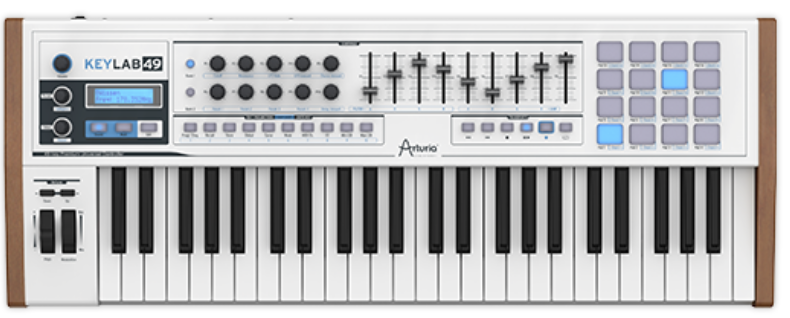








Ok so this is one of those things that you need to just jump on right now… don’t wait on this. 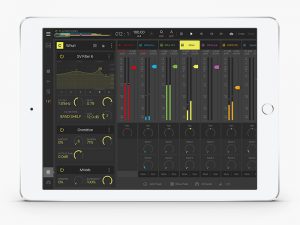
BeatMaker 3 is free through out winter NAMM 2018 … yeah thats right … the $20+ app is completely free right now.
This is the full app and I have to say I have been using it for a while now, it is really deep.
If you know someone who likes to make music and has an iPad, let them know about this one.
Pricing and Availability:
BeatMaker 3 is free to download from the App Store now until the end of NAMM.
|
|||||||
|
|||||||
|
Audio Damage is Has released 3 new plug in VSTs available directly from their site. New versions of the Delay Plug in “Dubstation 2″, Reverb Plug in ” EOS 2 ” and the all new waveshaping distortion “Grind” are now available.
EOS 2 consists of four high-quality custom-designed reverb algorithms, made with the modern production environment in mind. Three different plate simulators and Audio Damage’s own Superhall algorithm give you a broad palette of reverb, and the easy-to-understand interface makes adjusting the algorithms to suit your track incredibly simple.

From the Audio damage site:
The original dub delay plugin and still the best! Dubstation 2 takes our most popular product and adds a whole raft of new features, including a dual mode for separate control over the left and right delay times, ping-pong, a new feedback saturation algorithm, and an LFO. Along with an all-new procedural and Retina-friendly user interface and (FINALLY!) ProTools compatibility, this represents a major leap forward for one of our signature products.
All those bells and whistles aside, the heart of Dubstation is our painstaking bucket-brigade delay model. Often imitated, but never duplicated, Dubstation has been the go-to plugin for that sound for over a decade, used in thousands of commercial productions, and with good reason. With the addition of the LFO and saturation controls, Dubstation has moved in to the realm of tape delay emulation as well, and is a sonic Swiss Army knife for delay. 
from the AD site:
A true powerhouse of audio warfare, Grind puts the “damage” in Audio Damage. From subtle tube-style saturation to full-on mangled wavetable distortion, Grind is a Swiss Army Knife of sound design.
Grind consists of three main blocks: wavetable lookup, in to algorithmic saturation/distortion/, and finally to a multi-mode filter. The wavetable module uses the amplitude of the incoming signal to replace the sample with one from 15 different linearly-interpolated wavetables, chosen for their mangling potential. Window size and phase controls provide further tone-shaping possibilities.
The next stop is the algorithm module, with eleven different distortion and saturation algorithms, from simple soft-knee saturation on up to full on sine warping.
After this, the signal passes through a multi-mode filter stage, with eleven different filter models to choose from, including “vintage digital” versions from the early days of plugin development, on up to our modern analog-modeled MS20-style lowpass and highpass synth filters. A tempo-synced LFO provides motion for the filter frequency, and a final stage of soft clipping and DC filtering tames the output.
Make no mistake: this is not a subtle, polite tool. With careful tuning of the provided presets, it can be tamed to normal filtering and saturation duties, but on the whole, it is a noisy, snorting beast of a plug-in, and is happiest with Full Metal audio destruction. 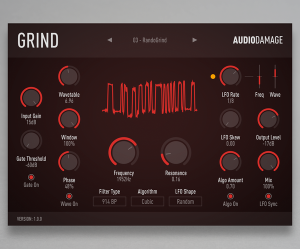
OK enough with the AD copy. I have had some time with all three of these (I even created a group of presets for Dubstation 2). I can say these are a really nice step forward in the Audio Damage line up. The UI is really impoved on these (Grind and EOS2 have some killer front end graphics to help understand whats going on).
Grind really impressed me in its filter types as well as how the distortions can take a plain sound and add a ton of movement and character. Similar to the Eurorack module Shapes also from Audio Damage, Grind lets you sequence lookup tables and waveshaping wavetables… very freaking cool.
tempo syncing the waveshaping and filter frequency changes is a joy.
Dubstation 2 is a very straight foward BBD sounding delay that will let you just easily get that dub delay you are after without a cluttered interface.
EOS 2 is just a joy to look at and hear. I’ve been using this to create gorgeous synth pads and basically create environments for my instruments to breathe in.
Plugin Alliance, a new ‘Über-standard’ supporting all major plugin formats and uniting some of the best-known international audio companies under one virtual roof, is proud to announce availability of SPL’s Attacker Plus, De-Verb Plus, and Mo-Verb Plus — new and improved versions of three must-have Microplugs created by founding Plugin Alliance development partner Brainworx in close collaboration with SPL, respected worldwide for its innovative and user-friendly approach to developing and manufacturing analog and digital audio gear for the music, film, multimedia, and broadcasting industries since 1984 — as of March 13…
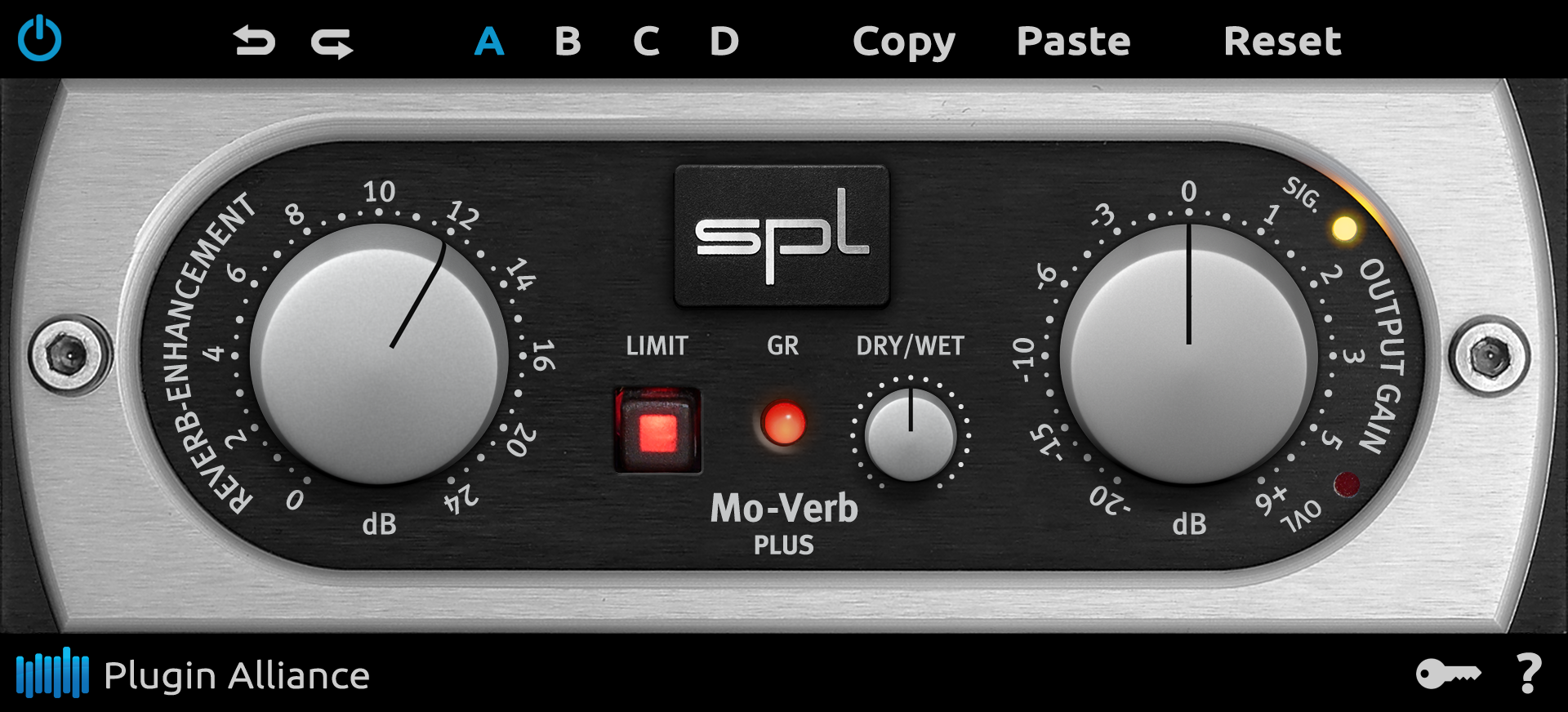 The Attacker Plus Microplug presents part of the same stunning envelope shaping supplied by SPL’s treasured Transient Designer hardware, hitting a home run with software aficionados by replicating the edge and punch provided by the original unit’s ATTACK knob. Indeed, it uses the same so-called Differential Envelope Technology that revolutionized dynamic processing with its level-independent methodology. More meaningfully, though its ATTACK knob lets users dial in all the transient punch needed, Attacker Plus also sports soft peak limiting (LIMIT) access and a DRY/WET control, affording total flexibility across a wide range of material with worry-free workflow in the digital world. With over a decade of hardware modelling experience, Brainworx bestowed a core algorithm upon Attacker Plus that more closely matches the behavior of the original Transient Designer hardware than ever before. Better still, working with Attacker Plus could not be simpler — all attack events can be amplified regardless of signal level, yet such simplicity does not prevent seemingly endless possibilities for studio and live applications. Attacker Plus amplifies just the attack curves of a sound event by focusing on the initial transient instead of specific frequencies to allow instruments to be mixed at lower levels, which, in turn, opens up space in the mix while preserving the relationship between tracks, for example; emphasize the attack of a kick drum or loop to increase power and presence in the mix; adjust apparent ‘distance’ of a microphone by varying the ATTACK values; increase the attack of guitar sounds for in-your-face tone-shaping — anything and everything is possible (within reason)!
The Attacker Plus Microplug presents part of the same stunning envelope shaping supplied by SPL’s treasured Transient Designer hardware, hitting a home run with software aficionados by replicating the edge and punch provided by the original unit’s ATTACK knob. Indeed, it uses the same so-called Differential Envelope Technology that revolutionized dynamic processing with its level-independent methodology. More meaningfully, though its ATTACK knob lets users dial in all the transient punch needed, Attacker Plus also sports soft peak limiting (LIMIT) access and a DRY/WET control, affording total flexibility across a wide range of material with worry-free workflow in the digital world. With over a decade of hardware modelling experience, Brainworx bestowed a core algorithm upon Attacker Plus that more closely matches the behavior of the original Transient Designer hardware than ever before. Better still, working with Attacker Plus could not be simpler — all attack events can be amplified regardless of signal level, yet such simplicity does not prevent seemingly endless possibilities for studio and live applications. Attacker Plus amplifies just the attack curves of a sound event by focusing on the initial transient instead of specific frequencies to allow instruments to be mixed at lower levels, which, in turn, opens up space in the mix while preserving the relationship between tracks, for example; emphasize the attack of a kick drum or loop to increase power and presence in the mix; adjust apparent ‘distance’ of a microphone by varying the ATTACK values; increase the attack of guitar sounds for in-your-face tone-shaping — anything and everything is possible (within reason)!
Thanks to that same Differential Envelope Technology, the De-Verb Plus Microplug also serves up part of the same stunning envelope shaping supplied by SPL’s treasured Transient Designer hardware in software. It reproduces the attenuation provided by the original SUSTAIN knob — albeit now helpfully labelled as REVERB REDUCTION on the Microplug itself — to reduce or even eliminate the decay of a sound. Similarly sporting soft peak limiting (LIMIT) access and a DRY/WET control, it also allows total flexibility across a wide range of material with worry-free workflow in the digital world. Working with De-Verb Plus is, likewise, disarmingly simple — reverb events can be reduced, regardless of signal level, translating to endless possibilities for studio and live applications! Any sound event’s decay curve can simply be reduced by turning that REVERB REDUCTION knob. De-Verb Plus also offers an OUTPUT GAIN control that allows compensation for level changes after processing the signal — just like Attacker Plus. Combined with the peak limiter (LIMIT) and DRY/WET controls, this ensures simple and safe adjustment of levels while avoiding internal clipping and shaping the decay characteristics of material. Musically shorten the sustain period of a snare; reduce tom-tom ring without resorting to physically dampening; adjust apparent ‘distance’ of a microphone by varying the REVERB REDUCTION values… De-Verb Plus perfectly encapsulates an alternative to noise gates — compared to fixed release times, the decay period is more musically shortened, so significantly freeing a drum kit from unwanted room information within seconds!
Similarly, the Mo-Verb Plus Microplug perfectly zeros in on another aspect of the Transient Designer’s distinctive envelope shaping, this time replicating the boost provided by the hardware’s SUSTAIN knob that extends the decay of sounds as a self-explanatory REVERB ENHANCEMENT control, allowing all reverb events to be amplified — again, regardless of signal level. Translating to endless possibilities for studio and live applications, decay curves of any sound event can be emphasized by simply turning the knob in question! Mo-Verb Plus also offers an OUTPUT GAIN control that allows compensation for level changes after processing the signal, which — when combined with the peak limiter (LIMIT) and DRY/WET controls — secures simple and safe adjustment of levels while avoiding internal clipping when shaping the decay characteristics of material. Many effects — such as drawing out the sustain period of a snare to get the tone and grit upfront in the mix or letting every note of a guitar riff ‘sing’ to its heart’s content — would take considerable programming skill when using a typical compressor, but Mo-Verb Plus handles everything easily with only one knob… just like its new and improved Attacker Plus and De-Verb Plus siblings!

Attacker Plus ($99.00 USD), De-Verb Plus ($79.00 USD), and Mo-Verb Plus ($79.00 USD) are available for purchase — as a AAX DSP-, AAX Native-, AU-, VST2-, and VST3-supporting Microplugs for Mac OS X (10.8 through 10.12), Windows (7 through 10), and Pro Tools 10.3.10 (or higher) — from Plugin Alliance and select VSSD (Virtual Stock Software Distribution) retailers. (Note that individual Microplug promotional pricing of $29.00 USD is available to owners of legacy Attacker, De-Verb, and Mo-Verb.)
For more in-depth info, including several superb-sounding audio demos, please visit the Microplugs’ respective dedicated webpages here:
https://www.plugin-alliance.com/en/products/spl_attacker_plus.html
https://www.plugin-alliance.com/en/products/spl_de-verb_plus.html
https://www.plugin-alliance.com/en/products/spl_mo-verb_plus.html
The new and improved Attacker Plus, De-Verb Plus, and Mo-Verb Plus Microplugs can be seen and heard in this trailer video: https://youtu.be/NqV3qqACE1Q
ZAOR Studio Furniture YESK Production desk
review by Flux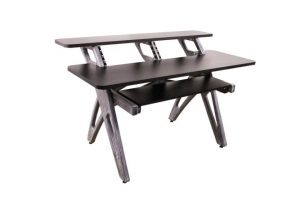 The Yesk is the latest production desk from boutique studio desk manufacturer ZAOR. The Yesk is a three tier desk with a slide out keyboard tray perfect for 49-61 keys. the center console features two bays of 4U of rack space at a nice working angle. The construction is of solid wood and feels extremely sturdy. One of my personal concerns about this review was that I know I will be moving in semi near future, will this desk hold up after a tear down and rebuild. I can say that after putting the desk together and seeing the smart anchor system that it uses to assemble the individual pieces (it comes flat packed), I have no doubts it will fair well in the move. Build time was pretty short (under two hours with me basically half paying attention to the build and half paying attention to another project I was working on. I’d bet with some focus I could have pulled it off in about 45 minutes. The instructions are very well layed out and it is really only about 11 parts or so you need to join together. The only gripes I had during the build was that the adapters for the rack screws could have come preinstalled and that the bottom row of them are a very tight fit to the desk. Nothing really upsetting just nitpicking for the sake of this article really. Continue reading
The Yesk is the latest production desk from boutique studio desk manufacturer ZAOR. The Yesk is a three tier desk with a slide out keyboard tray perfect for 49-61 keys. the center console features two bays of 4U of rack space at a nice working angle. The construction is of solid wood and feels extremely sturdy. One of my personal concerns about this review was that I know I will be moving in semi near future, will this desk hold up after a tear down and rebuild. I can say that after putting the desk together and seeing the smart anchor system that it uses to assemble the individual pieces (it comes flat packed), I have no doubts it will fair well in the move. Build time was pretty short (under two hours with me basically half paying attention to the build and half paying attention to another project I was working on. I’d bet with some focus I could have pulled it off in about 45 minutes. The instructions are very well layed out and it is really only about 11 parts or so you need to join together. The only gripes I had during the build was that the adapters for the rack screws could have come preinstalled and that the bottom row of them are a very tight fit to the desk. Nothing really upsetting just nitpicking for the sake of this article really. Continue reading
